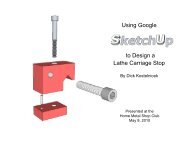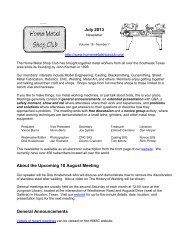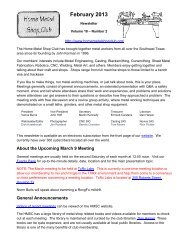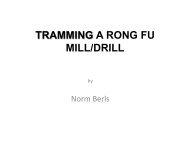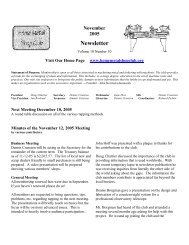October 2009 - Home Metal Shop Club
October 2009 - Home Metal Shop Club
October 2009 - Home Metal Shop Club
Create successful ePaper yourself
Turn your PDF publications into a flip-book with our unique Google optimized e-Paper software.
<strong>October</strong> <strong>2009</strong> - <strong>Home</strong> <strong>Metal</strong> <strong>Shop</strong> <strong>Club</strong> Newsletter - V.14 No.10<br />
Cutter”. As you can see, a large fixture supports hundreds of cutting blades, aligned to cut a<br />
full-length bat with one pass at the billet. These individual blades were identical to the blades on<br />
cabinetmakers’ hand-plane; small, flat, rectangles. The fixture provided mounting points and the<br />
blades were bolted to the apparatus, which provided approximate positioning. Retargeting and<br />
realignment must have been a nightmare. Now imagine placing the triangular log segment<br />
between the spindles, turning it at a high speed, and easing it into the counter-rotating fixture...<br />
Danger Will Robinson!<br />
Once in the plant<br />
proper, you are then<br />
taken into the<br />
woodturning lathe<br />
area, where manual<br />
turning is<br />
demonstrated. They<br />
then take you to the<br />
automated turning<br />
area, and explain how<br />
the Hemple Lathes were brought into the business, eliminating the 30 minute manual process,<br />
producing a profiled bat every thirty seconds. The cutter/vac assembly slides out of the way,<br />
back over the spindle, a billet is automatically centered, and then the cutter slides across the<br />
billet, cutting the bat in one pass as it follows a plate steel template. Professional bats are<br />
turned in the same fashion, however they are produced singly on a CNC system. Amazingly,<br />
little sawdust hits the floor, as the shop is surprisingly clean, with all of the collected waste going<br />
to Maine turkey farmers for bedding. The roughed bat is sent to the<br />
automated sanding systems, and then given the company brand. Ash bats<br />
are branded; Maple bats are labeled, being too structurally brittle to allow a<br />
brand. Aluminum Bats are manufactured in California.<br />
Glass Blowing Lathe<br />
By J. R. Williams<br />
I finished making a dual headstock glass<br />
blowing lathe. Two slow speed stepper<br />
motors are fed by a common signal<br />
source so the two timing belt driven<br />
headstocks are in synch. Headstocks,<br />
chucks, and lathe bed were all made by<br />
Taig Corp. Both headstocks are mounted<br />
on beveled mounting plates attached to<br />
the large base block and the cross slide.<br />
There is a rear mounted carbon gage<br />
block that is pressed against the softened<br />
glass with a profile specific to the part<br />
being formed. The gage block is pivoted<br />
and swings out of the way while heating<br />
the glass. The machine is intended for<br />
making decorative oil lamp globes about<br />
1-1/2 inch diameter and six inches long.<br />
4



